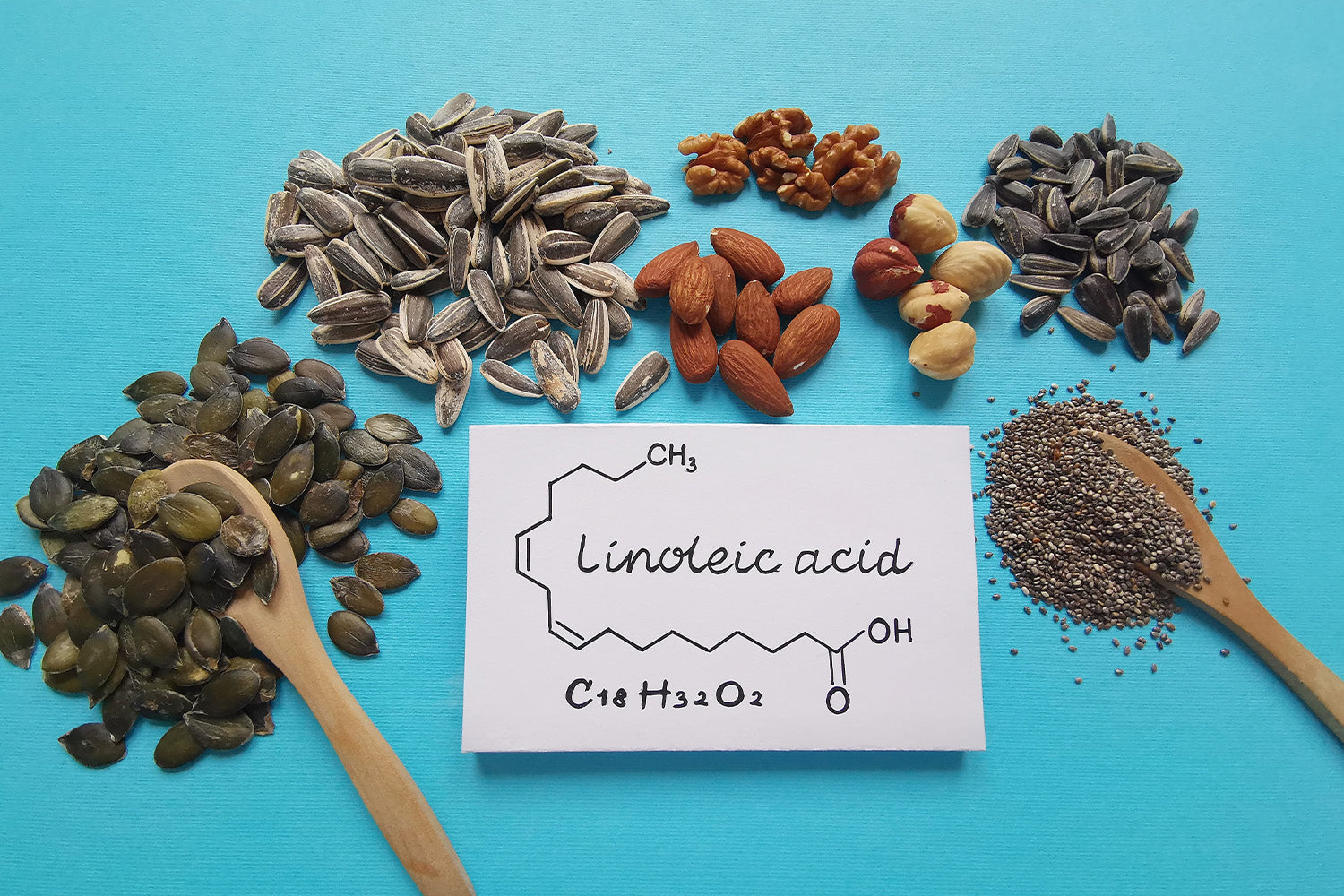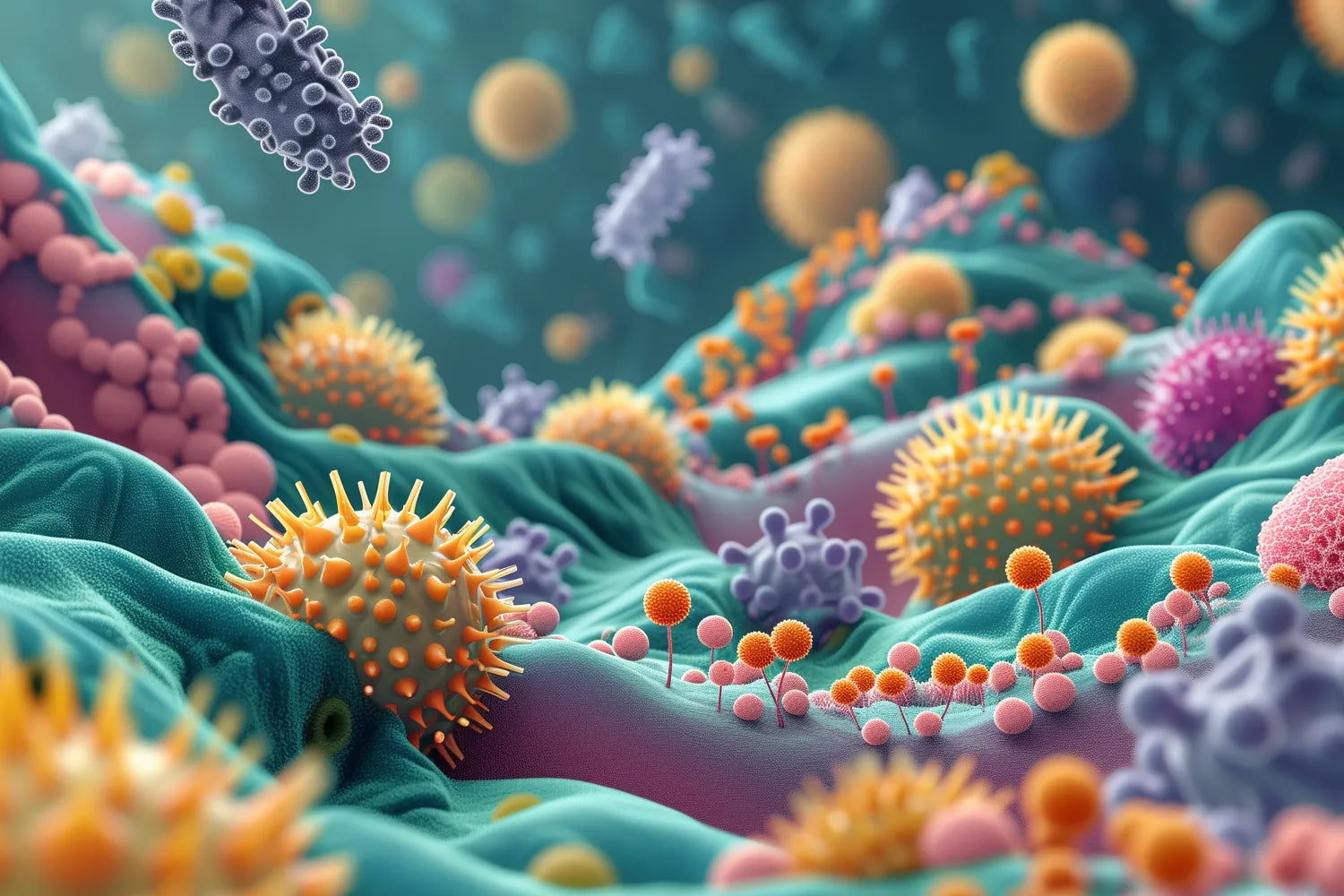
Dr. Eric Venn-Watson’s Highlights
-
Linoleic acid is an omega-6 fatty acid considered essential, meaning the body needs it to function but cannot make it on its own.
Taking linoleic acid may help your body produce more 2-AG, an endocannabinoid that can bind to CB1 and CB2 receptors.
Because linoleic acid has undesirable side effects, a better fatty acid, known as C15:0, has been discovered to activate a new, fully functioning endocannabinoid and deliver more promising health benefits.
Now that we know that all fat isn’t bad for us, it’s important to ensure the fats we are taking are beneficial. Your fatty acid intake is primarily established through dietary sources, but supplementation could be necessary if you have certain health conditions.
One type of fatty acid, linoleic acid (LA), gets little press but is worth examining in greater detail.
Linoleic Acid vs. Alpha-Linolenic Acid: What’s the Difference?
The information about fatty acids can be confusing, especially when some have very similar names. Two that sound the same but are different are linoleic acid and alpha-linolenic acid.
Alpha-Linolenic Acid
ALA is an omega-3 fatty acid in foods like flaxseed, canola oil, soy, and walnuts. Alpha-linolenic acid (ALA) is one of two essential omega fatty acids. Your body can convert ALA into docosahexaenoic acid (DHA) and eicosapentaenoic acid (EPA).
The other essential omega fatty acid is linoleic acid.
Linoleic Acid
This acid, and the topic of our discussion, is an omega-6 polyunsaturated fatty acid, also known as PUFA. Both dietarylinoleic acid and its cousin oleic acid are in high concentrations, primarily in seed oils and vegetable oils like canola, soybean oil, safflower oil, sunflower oil, olive oil, and corn oil.
The fatty acid composition of linoleic acid, also called octadecadienoic acid or cis-9, consists of two or more double bonds. It lacks the hydrogen atoms that saturated fats may have. Both ALA and LA are essential because the body doesn’t contain enzymes to create them (through the process of desaturation) from anything else.
How Linoleic Acid Works
The body metabolizeslinoleic acid by converting it to gamma-linolenic acid, which is then converted to dihomo-gamma-linolenic acid, which is an important component of neuronal membrane phospholipids.
This dihomo-gamma-linolenic acid is then finally converted to arachidonic acid. This acid is pretty controversial in the long-chain fatty acid sphere. Here’s why.
- On the one hand, when arachidonic acid levels are too high, it can lead to blood clotting, constriction of blood vessels, and the creation of more pro-inflammatory prostaglandins, like its n-6 fatty acid metabolites, making it bad for human health and resulting in an increased risk of comorbidities.
- On the other hand, arachidonic acid can form leukotrienes, which are anti-inflammatory molecules. It may also help lower LDL cholesterol (low-density lipoprotein cholesterol), boost HDL cholesterol, and could support healthy triglyceride levels. This can lower risk factors for medical conditions like atherosclerosis and heart disease.
Should You Try To Include More Linoleic Acid in Your Diet?
That’s a good question. Supplemental conjugated linoleic acid (CLA) is usually made from safflower oil. You get most of your CLA from dietary fat that comes from beef and dairy. As such, you probably aren’t deficient, and it isn’t likely you actually need it.
Most of the time, the people who are actively taking a CLA supplement are attempting to increase body mass, as in the case of bodybuilders or weightlifters. Because of the side effects referenced above, the average person who is not deficient shouldn’t consider taking a CLA supplement.
Can Linoleic Acid Support a Healthy Lifestyle?
Because it is an essential fatty acid, your body does need it to survive. Since you’re likely already getting enough of it in your diet, there are other ways you can support a healthy lifestyle that are more beneficial.
- Maintaining a healthy body weight. Excess body fat (adipose tissue) is unhealthy and can lead to negative health conditions like insulin resistance, type 2 diabetes, high blood pressure, and high cholesterol. If you have excess weight, take steps to lose it.
- Getting plenty of exercise. The American Heart Association recommends getting at least 150 minutes of heart-pumping cardiovascular exercise each week. In addition, add two to three strength or resistance training sessions to help protect your bones and tone your muscles.
- Avoiding lifestyle habits that could harm your body, like smoking or long-term, unprotected exposure to the sun.
- Eating a balanced diet. To make sure that you aren’t deficient in omega-6, make sure you’re eating a balanced diet with plenty of fruits and vegetables, healthy fats, and lean proteins.
In terms of which fats to eat in your healthy diet, let’s turn back to our fatty acid discussion and find out if we really need to take a fatty acid supplement, and if so, which one is best.
One of the most interesting discoveries about how linoleic acid becomes arachidonic acid is how it interacts with the body’s endocannabinoid system. Let’s take a closer look.
What Is the Endocannabinoid System?
It wasn’t until the nineties that science recognized the endocannabinoid system as a fully functioning network of receptors and signals that plays a role in virtually every system in your body.
This network controls sleep, mood, hunger, immunity, alertness, and bodily temperature. As such, experts believe that learning how to interact with it better might lead to a better understanding of obesity, sleep issues, mood disorders, and new medicines and treatments for debilitating diseases.
The Cannabinoid Connection
The endocannabinoid system interacts with chemical compounds called cannabinoids. Specifically, cannabinoids connect with the receptors (CB1 and CB2) located within the endocannabinoid system.
CB1 Receptors: These receptors are located primarily in the central nervous system, including the brain and spinal cord.
CB2 Receptors: Found in the peripheral nervous system, or PNS. This includes all the nerves in your body. CB2 receptors can also be found in your immune cells, so activating the CB2 receptors helps modulate your immune function and immune responses.
Cannabinoids can be created synthetically, naturally found in plants, or made by our bodies. When our bodies make them, they’re called endocannabinoids.
The two most well studied endocannabinoids are anandamide (AEA) and 2-arachidonoylglycerol (2-AG). Of these two, only 2-AG is fully acting, which means it can bind to both CB1 and CB2 receptors.
The Linoleic Acid Path
Interestingly, arachidonic acid (which the body converts from linoleic acid) helps the body synthesize 2-AG, which means supplementing with omega-6 could produce more fully acting endocannabinoids circulating in the body.
The problem is linoleic acid is subject to oxidation, which means it can go rancid in a supplement before you even take it. Science, however, found a solution: C15:0, another essential fatty acid that the body can use to make a newly discovered, fully functioning endocannabinoid known as pentadecanoylcarnitine (PDC).
Elevate your cells. Elevate your self.
Buy NowC15:0: A Better, Broader, and Safer Essential Fatty Acid
We’ve heard that omegas can help lower our risk of cardiovascular disease and keep us healthy. Most people start taking an omega supplement to support heart health and protect against cardiovascular disease.
Our dietary intake of these essential lipids is usually enough. Still, supplementation might be necessary if you have an omega-3 fatty acid deficiency or have markers for coronary heart disease. A blood test can determine if you are deficient.
Unfortunately, the omegas also have an Achilles heel.
- Omegas and omega-3 fish oil are oils and thus, are subject to oxidation, which means they can go rancid. Independent researchers found that about one in ten fish oil supplements on store shelves were rancid before they were even purchased. If the supplement is rancid in the body, it will be rancid in your cells. Researchers aren’t yet sure how damaging rancid omega-3fish oil supplements are, but several studies have indicated that taking rancid supplements have a negative impact on cholesterol levels. That means one of the very reasons you’d be taking the supplement (to support healthy cholesterol levels) would be void.
Additionally, science supports that C15:0 has many benefits over omega-3s:
- When C15:0 was compared to the purest omega-3 in a peer-reviewed study, C15:0 was found to have broader clinically relevant benefits, repairing 10 out of 12 cell types studied. In fact, it had more than 26 benefits, making it much more productive inside our bodies than an omega.
- Some omegas could be toxic to your cells, while C15:0 was found to be safe for 12 out of 12 cell types studied. Omega-3’s (EPA) was found to be toxic to lung and blood vessel cells at the highest doses.
- Additionally, taking too much omega could lead to unhealthy low blood pressure, thinning of the blood, excess bleeding if an injury were to occur, and bruising easily. Not to mention most of the supplements you take (derived from fish oil) give you a really unpleasant aftertaste. The problem is, “high levels” of omegas are usually what we take in supplement form, simply because the omegas we find in supplements are less bioavailable than they are from our food.
For these reasons, and for the health benefits provided by C15:0, the smarter choice for endocannabinoid synthesis and your total body health is C15:0.
What Is C:15:0?
C15:0 is an odd-chain saturated fatty acid that science supports as an essential fatty acid. In fact, C15:0 is the first essential fatty acid to be discovered since the omegas 90 years ago. Recent studies show that C15:0 is better, broader, and safer than the purest, highest-performing omega-3 (pure EPA).
How Was C15:0 Discovered?
In the beginning, the discovery had nothing to do with human studies but rather with animal studies. A husband and wife team studying the longevity of bottlenose dolphins discovered that, of two populations of dolphins, one population had significantly fewer age-related illnesses than the other. What they discovered was that the healthier population had access to a diet that consisted of fish containing C15:0.
They took their research further and discovered that the same age-protective health effects available to the dolphins were also available to humans. They published their research in Nature Scientific Reports in 2020, and continued their studies, finding a new way for humans to get the amount of C15:0 they need in their diets without attaching unhealthy, even-chain saturated fats and added calories to it.
What Does C:15:0 Do?
In addition to being the key to producing the second ever to be discovered fully-acting endocannabinoid, C15:0 supports your health by strengthening your cells and balancing bodily functions.
-
Protect cell membranes. C15:0 is a sturdy fat that supports your cell’s structure by strengthening your cells and acting as a shield of armor for your cell membranes.
-
Balance your immunity.Fatty15 helps calm and lower pro-inflammatory cytokines, which are associated with age-related breakdown.
-
Promote healthy metabolism.Fatty15 activates AMPK, PPARɑ and PPARẟ receptors. These receptors modulate metabolic, immune, heart, and liver function. By activating these receptors, fatty15 helps keep our metabolism balanced.
-
Support red blood cell health. Fatty15 bolsters red blood cell health, promoting their proper function and purpose, so they can carry oxygen to every part of your body and keep the rest of your body functioning as it should, too.
-
Increase mitochondrial function. As we get older, the mitochondria in our cells that act as their batteries begin to decline. With slower mitochondrial function, we experience a slowdown throughout our entire bodies. C15:0 helps boost mitochondrial function by up to 45%, so your cells can stay supercharged, and so can you.
-
Increases ATP levels. ATP is the energy currency in your body. It’s a molecule required for fueling energy creation on all levels, starting in your cells. With age, ATP levels naturally begin to decline. In one study, C15:0 increased ATP levels in the cells by 350%. That equates to more cellular power, which translates to a more energized you.
By performing these functions and improving your cellular health, fatty15helps reverse cellular aging.*†In addition to taking care of your body by getting plenty of exercise, eating healthfully, and avoiding behaviors like smoking or exposure to toxins, adding fatty15 to your health-stack is one of the easiest things you can do to improve your health. Taking fatty15 each day can help you age on your own terms, which can keep you doing the things you love, longer.
Fatty15: Your Easy C15:0 Source
C15:0 is primarily found in trace levels in whole-fat dairy products. However, increasing your intake of whole-fat dairy products comes with extra calories, sugars, and high levels of the "bad" even-chain saturated fats.
A solution? Fatty15.
Fatty15 is a breakthrough supplement borne from scientific discovery, containing one pure ingredient, FA15™. This vegan-friendly, sustainable ingredient contains the just the right amount of pentadecanoic acid to restore your body’s circulating levels, all without any kind of fishy aftertaste or bad side effects. In fact, only one side effect is known from taking fatty15: decreased snacking between meals. That’s probably a benefit most of us can appreciate, especially while attempting to maintain a healthy weight.
You could feel better, function better, and age on your terms by taking this once-a-day supplement that supports your long-term health & wellness, especially as you age.
Fatty Acids For Life
Including enough essential fatty acids in your diet is important. Chances are you are likely already getting plenty of linoleic acid from your diet. While you might be tempted to take a fish oil capsule to increase your omega-3 intake, it may be a better option to consider getting your omega-3 from dietary sources (like fatty fish) and focus on supplementing with C15:0, an essential fatty acid that you probably aren’t getting through your diet. The best way to get it? Fatty15. Sustainably produced and vegan-friendly, it’s the essential, pure, and award winning fatty acid supplement that your body needs.
Sources:
Alpha-linolenic acid Information | Mount Sinai - New York
What is Linoleic Acid?|News-Medical.net
The endocannabinoid system: Essential and mysterious - Harvard Health
Revealed: many common omega-3fish oilsupplements are ‘rancid’|The Guardian
Health Implications of High Dietary Omega-6 Polyunsaturated Fatty Acids |J Nutr|PMC
American Heart Association Recommendations for Physical Activity in Adults and Kids

Eric Venn-Watson M.D.
CEO, Co-Founder
Senior Scientist, Co-Founder
Eric is a physician, U.S. Navy veteran, and Co-founder and COO of Seraphina Therapeutics. Eric served over 25 years as a Navy and Marine Corps physician, working with the special forces community to improve their health and fitness. Seraphina Therapeutics is a health and wellness company dedicated to advancing global health through the discovery of essential fatty acids and micronutrient therapeutics.
You May Also Like...
10 Foods Good for Your Liver: The Ultimate Guide
Your liver does a lot for you. If it had a voice of its own, it might ask you to eat more veggies and cut back on your Old Fashioneds. Unfortunately, the liver doesn’t receive a lot of attention until...
How To Improve Your Gut Microbiome: 6 Tips
Interested in how to improve your gut microbiome? We’ve got six tips to help your gut thrive and improve your overall digestion.


